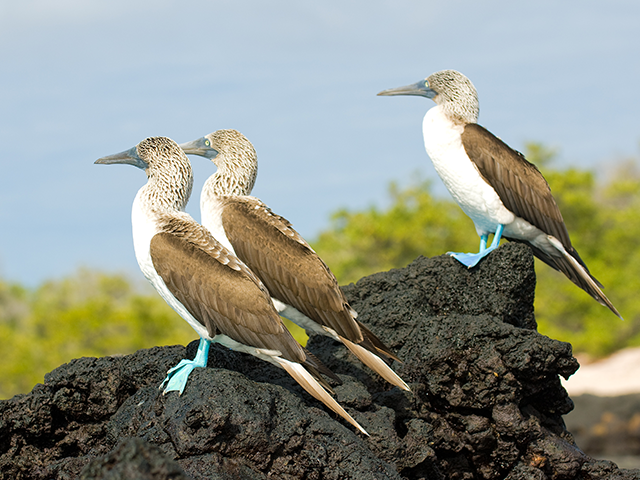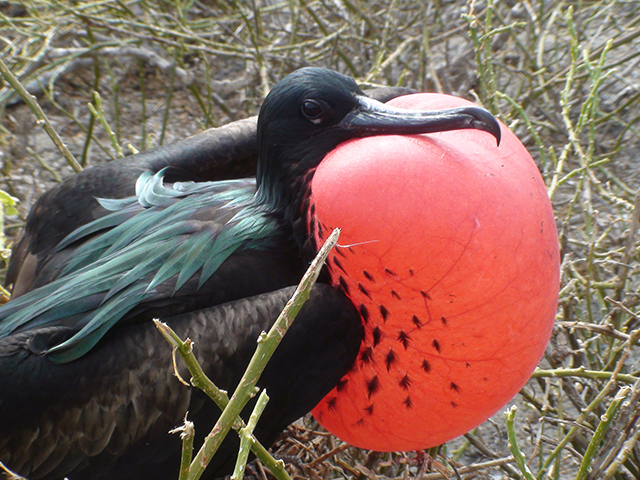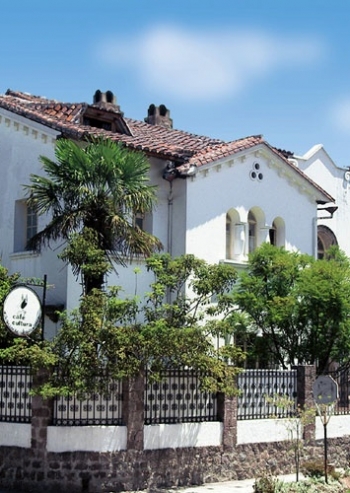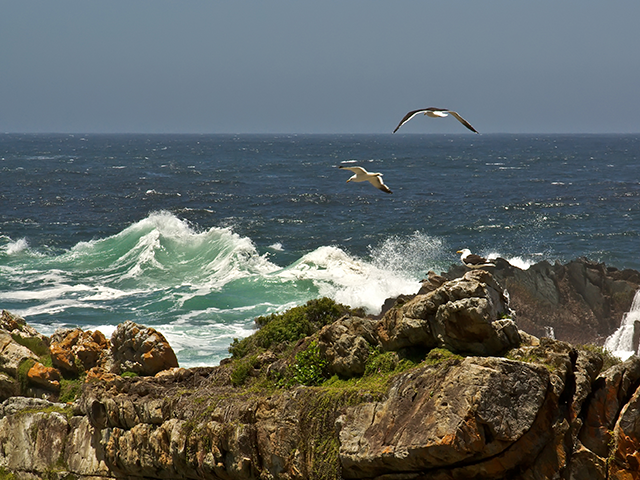- 1Guayaquil
Today is the first day of your holiday in Ecuador. On arrival at Guayaquil, you will be transferred to your accommodation for the day.
Meals: No mealsAccommodation: Continental Hotel - 2Cerro Blanco Reserve
On day two, we will start early and head for Cerro Blanco Reserve. Situated in the Tumbesian eco-region, this reserve is managed by Fundación Pro-Bosque. Its tropical dry forests are home to the Ecuadorian Ground Dove, Gray-cheek Parakeet, Ecuadorian Pikulet, Scarlet-backed Woodpecker, Blackish-headed Spine Tail and other prominent birds of this region such as the great Green Macaw.
We will have packed lunch on the way. We then head for Puerto Hondo, a great place to observe shore birds like the Great Egret, Snowy Egret, Tricolored Heron, Green Kingfisher and Ringed Kingfisher.
Meals: Lunch (Box Lunch), DinnerAccommodation: Continental Hotel - 3Manglares Churute Ecological Reserve to Buenaventura Reserve
We will start our day early and move on to Manglares Churute Reserve. Here, we have the opportunity to observe the famous Horned Screamer. The other birds found in the reserve include Herons, Ducks and Woodpeckers. The shore birds that inhabit Manglares include the Gull, Spoonbill, Egret and Osprey. Manglares is also home to one of the last remaining mangrove forests of Ecuador.
After lunch we continue our journey, stopping at certain points to observe some of the shore birds that are special attractions in the area, such as the Baron´s Hermit, Ecuadorian Trogon, Jet Antbird, Superciliated Wren, Oranged-crowned Euphonia and Peruvian Meadowlark.
We will arrive at our next destination, Buenaventura Reserve, in time for dinner.
Meals: Lunch, DinnerAccommodation: At Buenaven - 4Buenaventura Reserve
Today we will spend most of our time exploring the reserve to find birds such as the Andean Tinamou, Rose Faced Parrot and Line-cheeked Spinetail.
Buenaventura Reserve was set up with the objective of preserving the Parakeet’s habitat- the tropical cloud forest region. The reserve is part of the Jocotoco Foundation and supports a rich variety of birdlife that includes many endemic species like the El Oro Parakeet, Emerald-billed Woodnymph, Pacific Tuftedcheek, Club-winged Manakin, Long Wattled Umbrella Bird and El Oro Tapaculo. The reserve is considered an ornithologist’s paradise. In 1980, the threatened El Oro Parakeet was found in this region.
Meals: Breakfast, Lunch, DinnerAccommodation: Buenaventura Reserve - 5Buenaventura Reserve to Jorupe Reserve
After breakfast we will have one last opportunity to observe the El Oro Parakeet. We then head for Jorupe, another Jocotoco Foundation Reserve. It is located close to Macará. Here we will look for endangered Tumbesian endemic species such as the Blackish Headed Spinetail, Slaty Becard, Line Cheeked Spinetail and Loja Tyranulet. Jorupe is also home to a number of globally threatened bird species such as Hena-hooded Foliage-gleaners. The reserve is known for its deciduous forests dominated by Ceiba trees as well.
Meals: Breakfast, DinnerAccommodation: At Jorupe Reserve - 6Jorupe Reserve to Utuana Reserve
In the morning we set out on a walk along the trails of the Jorupe Reserve. We will have packed lunch en route and move on to Utuana (Jocotoco Reserve), a montane scrub and woodland area where we look out for birds such as the Black-crested Tit-tyrant, Piura Hemispingus, Great Headed Antbird, Chapman Antshrike and Rainbow Starfrontlet.
Utuana Reserve is situated very close to the Peruvian border. It is managed jointly by Fundación Jocotoco and a Loja based conservation organization- Arcoiris. The objective of this reserve is to help in the conservation of a special type of high altitude epiphyte rich montane forest.
Meals: Lunch (Box lunch), DinnerAccommodation: At Utuana Reserve - 7Catamayo to Vilcabamba, Ecuador
On day seven, we start early and travel to Catamayo.
En route we will stop at various points to observe a number of Tumbesian and other assorted species like the Tumbes Sparrow, Band-tailed Sierra Finch and Drab Seedeater.
After lunch, we drive to Vilcabamba where we will have dinner and stay for the night. Apart from its rich wildlife, Vilcabamba is known as the Valley of Longevity because it is widely believed that its inhabitants live up to a ripe old age!
Meals : Lunch, DinnerAccommodation : Vilcabamba - 8Podocarpus National Park to Tapichalaca Reserve
Early in the morning we will visit Cajanuma, a part of Podocarpus National Park, where we will look out for spectacular birds like the Red-hooded Tanager, Bearded Guan, Gray breasted Mountain Toucan, Plumbeus Rail, Golden-plumed Parakeet, White-browed Spinetail, Elegant Crescent-chest, Chusquea tapaculo, Three Banded Warbler, Barred Fruiteater and Golden Crown Tanager. Podocarpus National Park is also renowned for its large number of lagoons (about a hundred). The best known among them is Lagunas del Compadre. In addition, a number of unique biological adaptations have been observed within the park, especially amongst its birds.
Later in the day, we travel to Tapichalaca Reserve, the first reserve created by the Jocotoco Foundation. Enjoy observing the Hummingbird species that fly around the feeders at this lodge, such as the Flame throated Sunangel, Rufous-Capped Thornbill, Chesnut Breasted Coronet and Long Tail Sylph.
Meals: DinnerAccommodation: At Tapichalaca Reserve - 9,10Tapichalaca Reserve
We will be spending the next two days in Tapichalaca Reserve. The Jocotoco Foundation bought the land of this reserve in order to protect the habitat of the Jocotoco Antpitta. This species was found in the region for the first time and it is known that most of the world’s Antpittas occur in this reserve. The other major attractions of the area are the Dusky Headed Parakeet, White Capped Parrot, Swallow Tail Nightjar, Gray Breasted Mountain Toucan, Ash-browed Spinetail, Chesnut-naped Antpitta, Rufous Tail Tyrant, Yellow Cheeked Becard, Black Faced Tanager and White Capped Tanager.
Meals: Breakfast,Lunch,DinnerAccommodation: At Tapichalaca Reserve - 11Tapichalaca Reserve to Podocarpus National Park
After breakfast we will continue on our expedition to Zamora Province. En route we can try and spot the Crimson Bellied Woodpecker, Tumbesian Tyranulet, Tawny Crowned Pygmy Tyrant and White Capped Dipper. Zamora is known as the Mining Capital of Ecuador and also as the City of Birds and Waterfalls. Our accommodation for the night is located next to Podocarpus National Park.
Meals: Breakfast, DinnerAccommodation: Copalinga Lodge - 12,13Podocarpus National Park
Over the next two days, we will hike along the trails of Podocarpus National Park and our lodge, looking for local species such as the Coppery Chested Jacamar, Ecuadorian Piedtail, White Breasted Parakeet, Chestnut Crowned Gnateater, Green Hermit, Spangled Coquette, Black Streaked Puffbird, Chestnut Tipped Toucanet and Blue Rumped Manakin.
Meals: Breakfast,Lunch,DinnerAccommodation: Copalinga Lodge - 14Podocarpus National Park to Quito
Today, we will explore the area one last time in search of species like Ecuadorian Tyrannulet, Lined Antshrike, Foothill Elaenia, Andean Cock of the Rock, Blue-browed Tanager, Chestnut-vented Conebill.
Later in the day we will return to Catamayo and drive around the airport to look for Tumbesian birds that we may have not seen. We will catch our flight back to Quito. On arrival at Quito, we will be transferred to our hotel.
Meals: DinnerAccommodation: Café Cultura Hotel - 15Quito
Our Endemic Birds of Ecuador expedition ends today. You will be transferred to the airport to catch your flight back home.
Meals: Breakfast
- Accommodation and meals as indicated in the itinerary
- Airport transfers
- Ground transportation with an English speaking driver/guide
- Information Kit
- Park or reserve entry fees
- Permits or equipments as mentioned in the itinerary
- Sightseeing or activities or safaris as mentioned in the itinerary
- Taxes
- All items of personal nature
- Any increase in taxes, fuel cost and emergency rescue costs
- Domestic airfare or Train fare
- Gratuities and Tips
- International airfare
- Meals and drinks not specified in the itinerary
- Optional activities (if any) and personal expenses
- Registered Guides
- Souvenirs
- Visas, Vaccination and Insurance
Requires a spirit of adventure and some degree of fitness, as the trip might consist of many activities or long journeys. These adventures involve walking, trekking, hiking, cycling, rafting, sea kayaking, or driving for long hours, at times for up to six to eight hours a day at a steady pace. The maximum altitude is 3000m, so it requires you to be reasonably physically fit because you may be travelling in extreme weather conditions. The trips are usually 6 to 12 days in duration.






